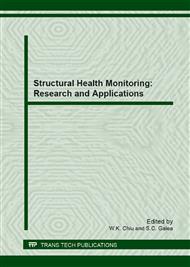[1]
Wilcox P.D, Lee C.K, Scholey J.J, Quantitative structural health monitoring using acoustic emission, Proc. of SPIE Vol. 6173, 61731K, (2006).
Google Scholar
[2]
Muravin B, Muravin G, Lezvinsky L, "The Fundamentals of Structural Health Monitoring by the Acoustic Emission Method", Proceedings of the 20th International Acoustic Emission Symposium, November 17-19, Kumamoto, Japan, (2010) pp.253-258.
Google Scholar
[3]
Surgeon, M., Wevers, M., Modal analysis of acoustic emission signals from CFRP laminates. NDT&E International 32 (1999) 311–322.
DOI: 10.1016/s0963-8695(98)00077-2
Google Scholar
[4]
Gorman M R & Prosser W H, , "AE Source Orientation by Plate Wave Analysis", Journal of Acoustic Emission, vol. 9(4), (1991) p.283 – 288.
Google Scholar
[5]
Diamanti K., Soutis C., Structural health monitoring techniques for aircraft composite structure, Progress in Aerospace Sciences 46 (2010) pp.342-352.
DOI: 10.1016/j.paerosci.2010.05.001
Google Scholar
[6]
Jingpin Jiao, Cunfu He, Bin Wu, Renyuan Fei, and Xiuyan Wang, "Application of wavelet transform on modal acoustic emission source location in thin plates with one sensor," International Journal of Pressure Vessels and Piping 81 (2004), 427–431.
DOI: 10.1016/j.ijpvp.2004.03.009
Google Scholar
[7]
Jiao Jing-Pin, He Cun-Fu, Wu Bin, Fei Ren-Yuan, Wang Xiu-Yan, A new acoustic emission source location technique based on wavelet transform and mode analysis, Front. Mech. Eng. China 3 (2006), 341− 345.
DOI: 10.1007/s11465-006-0006-4
Google Scholar
[8]
Jiao Jingpin, Wu Bin and He Cunfu, "Acoustic emission source location methods using mode and frequency analysis," Struct. Control Health Monit. 15 (2008) 642–651.
DOI: 10.1002/stc.220
Google Scholar
[9]
Oskouei, A.R., Ahmadi, M., "Using wavelet transform to locate acoustic emission source in composite plate with one sensor," Acoustics 08, Paris, (2008) 2211 - 2215.
DOI: 10.1121/1.2933779
Google Scholar
[10]
Hamstad MA, O'Gallagher A, and Gary J, , A wavelet transform applied to Acoustic Emission Signals: Part 2: Source location, Journal Acoustic Emission. 20 (2002) 62-82.
Google Scholar
[11]
Lam PM, Lau KT, Ling HY, Su Z, Tam HY. Acousto-ultrasonic sensing for delaminated GFRP composites using an embedded FBG sensor. Optics and Lasers in Engineering. 47 (2009) 1049–1055.
DOI: 10.1016/j.optlaseng.2009.01.010
Google Scholar
[12]
Daubechies I., The wavelet transform time-frequency localization and signal analysis, IEEE Transaction on Information. 36 (5), (1990) 961 – 1005.
DOI: 10.1109/18.57199
Google Scholar
[13]
Hafizi Z.M., Epaarachchi J., Lau K.T., Modal analysis of high frequency acoustic signal approach for progressive failure monitoring in thin composite plates, Second Malaysian postgraduate conference (MPC), 7-9 July, Queensland, Australia. (2012) 61 – 66.
Google Scholar
[14]
Ni Q.Q., Iwamoto M., Wavelet transform of acoustic signals in failure of model composites, Engineering Fracture Mechanics. 69 (2002) 717-728.
DOI: 10.1016/s0013-7944(01)00105-9
Google Scholar
[15]
Marec A, Thomas J.H., Guerjouma R.E., Damage characterization of polymer-based composite materials: Multivariable analysis and wavelet transform for clustering acoustic emission data, Mechanical Systems and Signal Processing. 22 (2008) 1441 – 1464.
DOI: 10.1016/j.ymssp.2007.11.029
Google Scholar
[16]
Chui CK, An introduction to wavelets, San Diego, CA: Academic Press; 1992.
Google Scholar
[17]
Simonovski I, Boltezar M, The norms and variance of gabor, morlet and general harmonic wavelet function, Journal of Sound and Vibration. 264 (2003) 545 – 557.
DOI: 10.1016/s0022-460x(02)01206-3
Google Scholar
[18]
Lin J, Feature extraction of machine sound using wavelet and its aplication in fault diagnosis, NDT & E International. 34 (2001) 25 – 30.
DOI: 10.1016/s0963-8695(00)00025-6
Google Scholar
[19]
S. Barré S., Benzeggagh M.L., On the use of acoustic emission to investigate damage mechanisms in glass-fibre-reinforced polypropylene, Composites Science and Technology. 52(3), (1994) 369–376.
DOI: 10.1016/0266-3538(94)90171-6
Google Scholar


